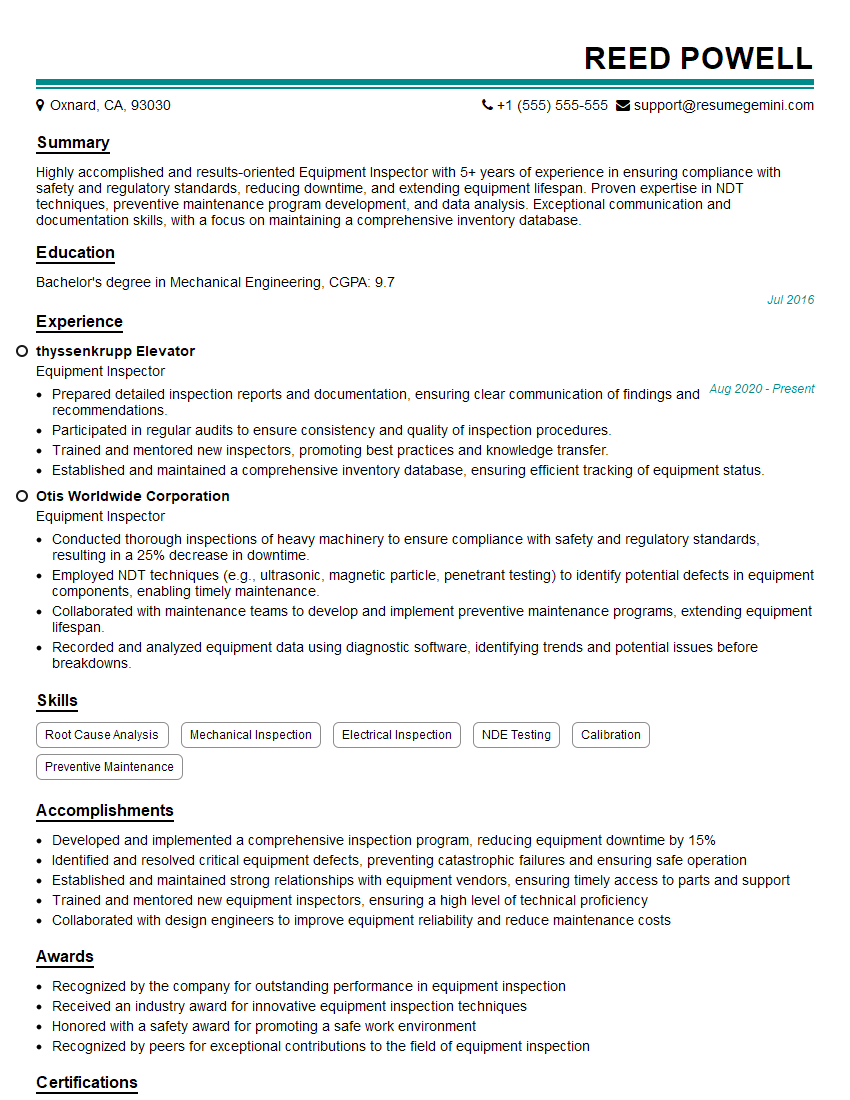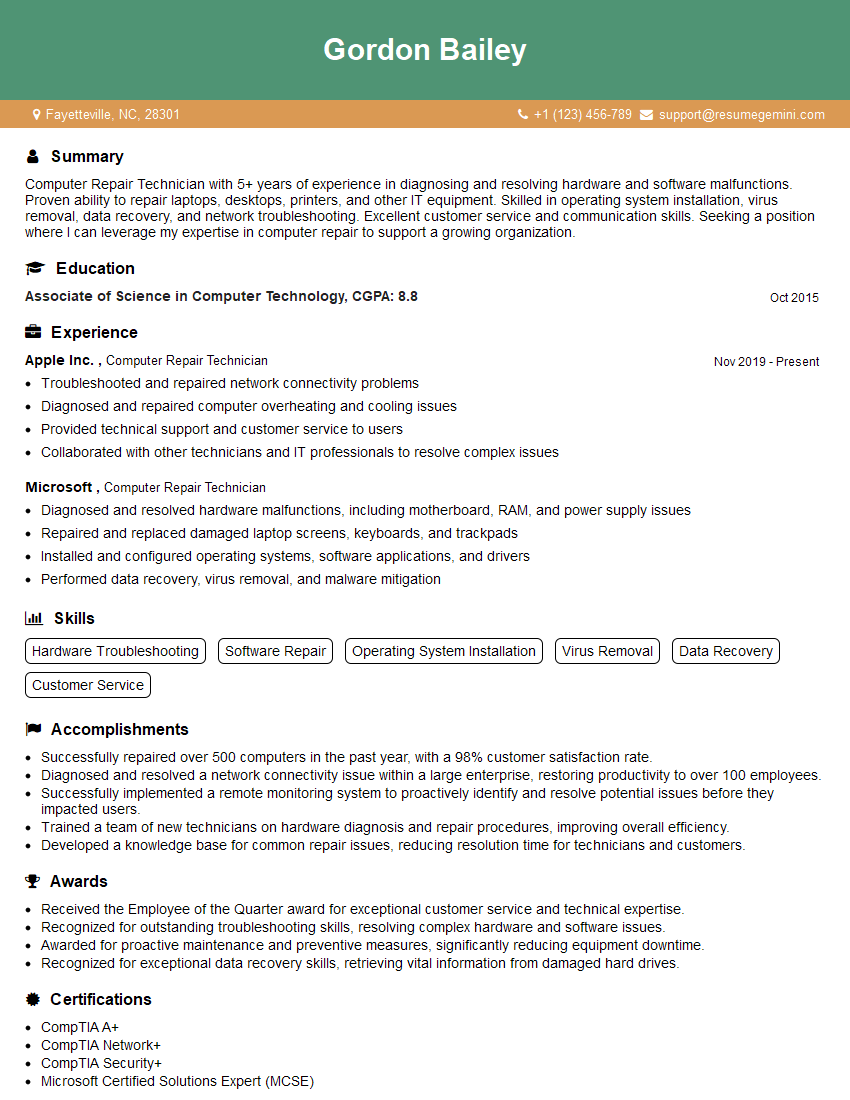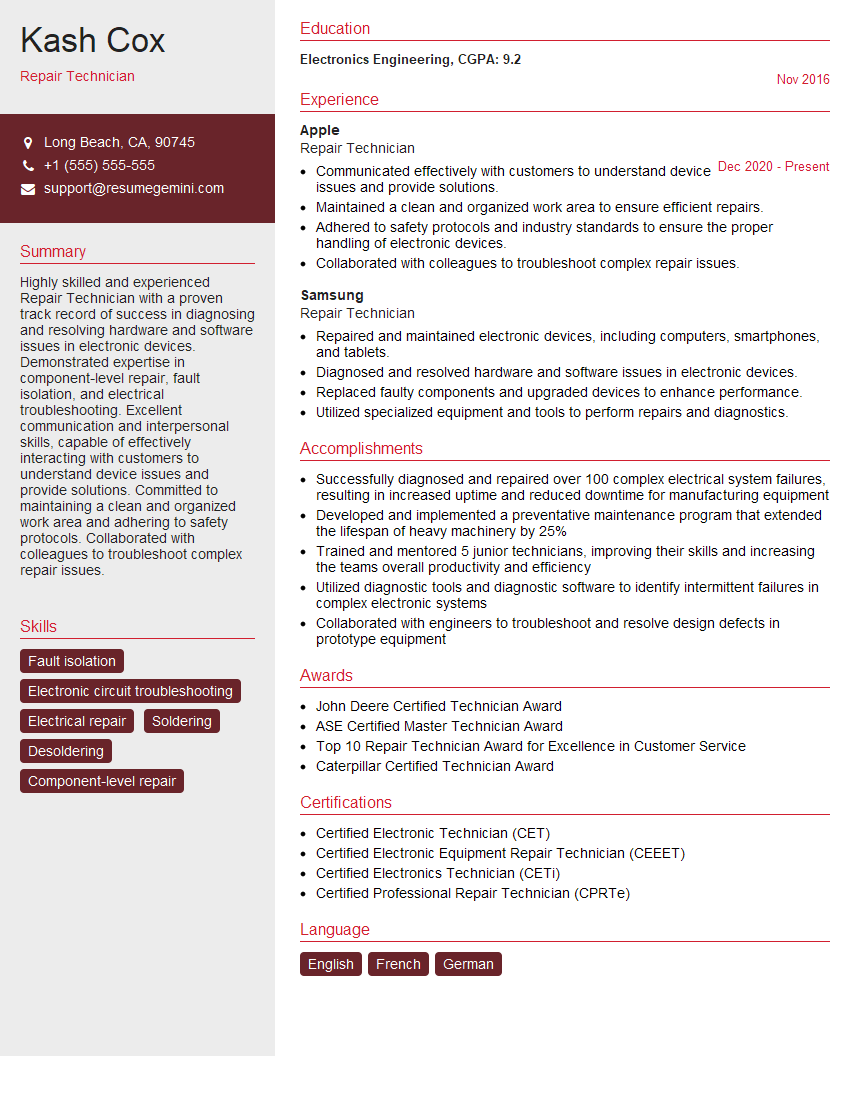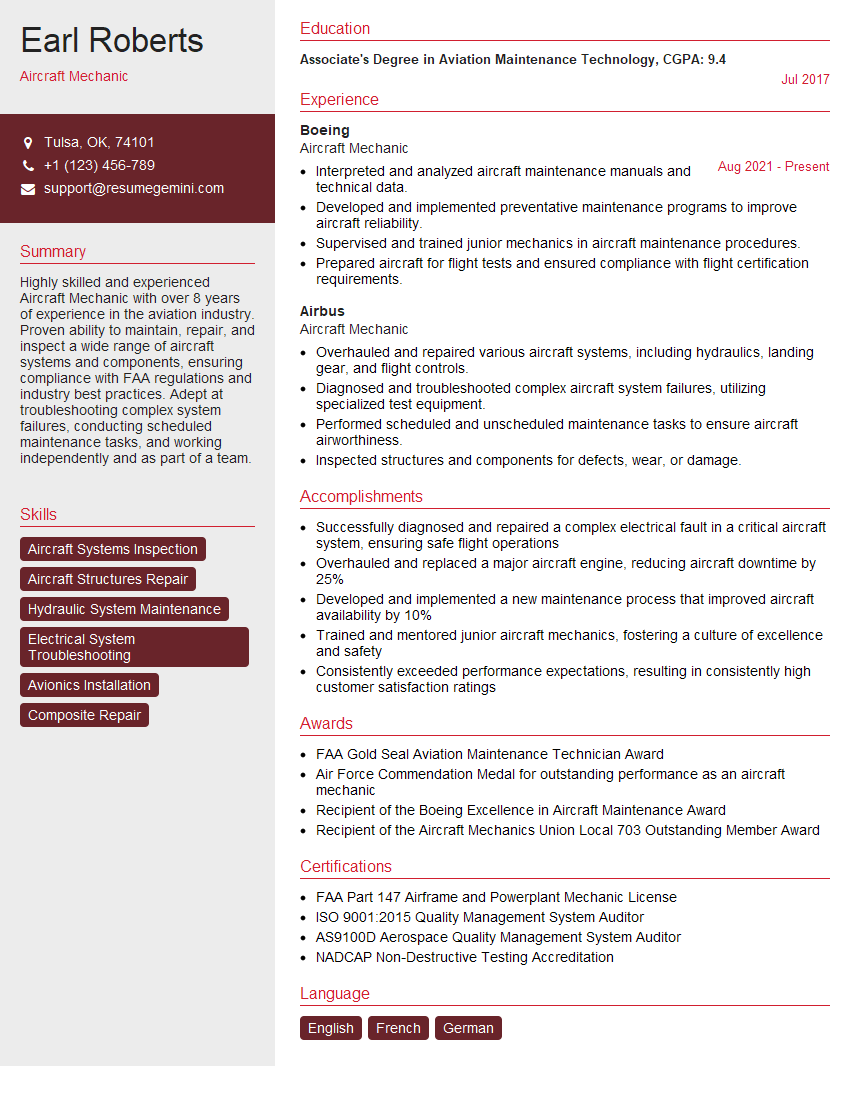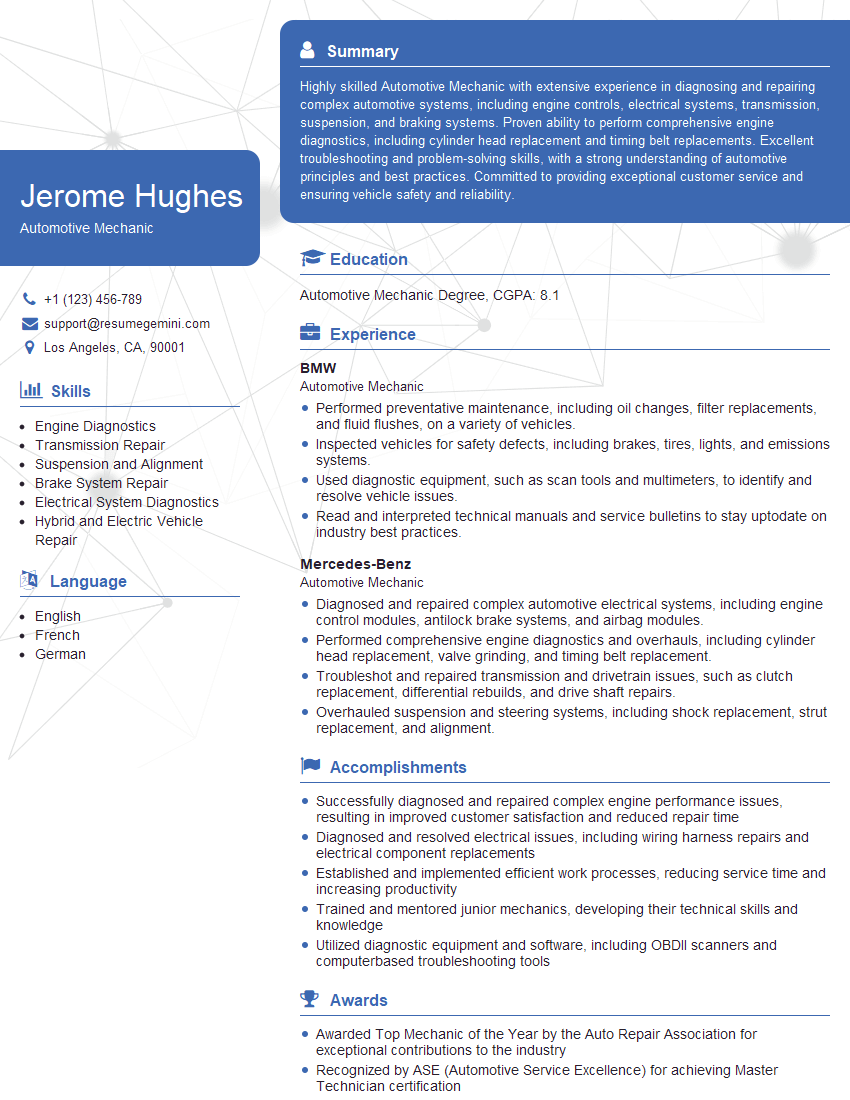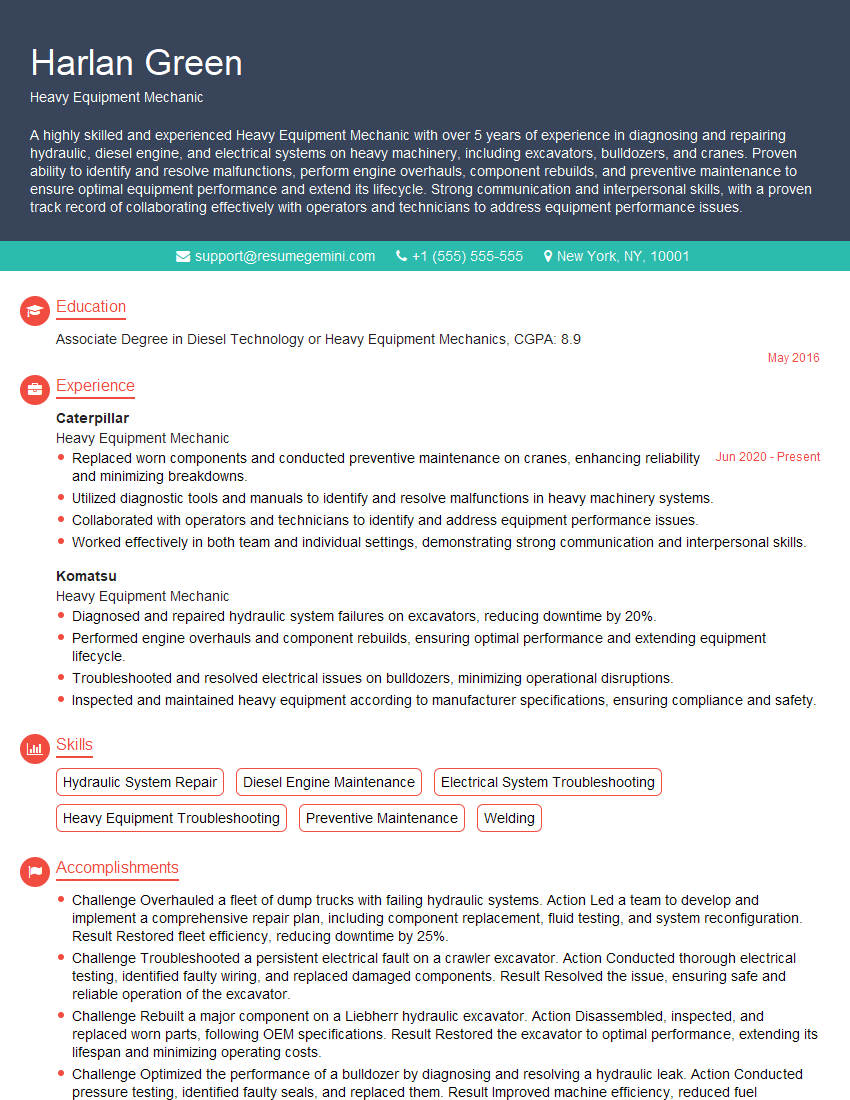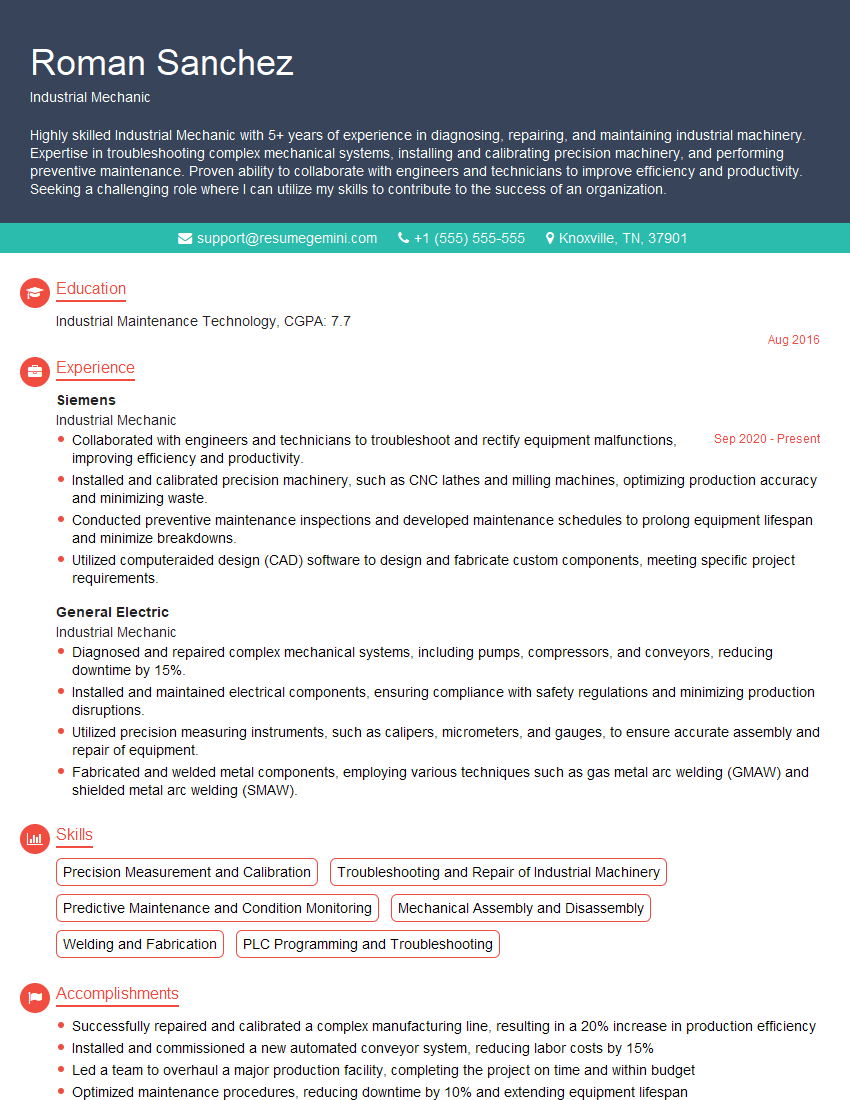Unlock your full potential by mastering the most common Inspect and repair equipment interview questions. This blog offers a deep dive into the critical topics, ensuring you’re not only prepared to answer but to excel. With these insights, you’ll approach your interview with clarity and confidence.
Questions Asked in Inspect and repair equipment Interview
Q 1. Describe your experience with preventative maintenance procedures.
Preventative maintenance is crucial for extending equipment lifespan and preventing costly breakdowns. My approach involves a structured process combining scheduled inspections, lubrication, and component replacements based on manufacturer recommendations and operational history.
For instance, in maintaining a conveyor system, I’d adhere to a schedule that includes daily visual inspections for loose parts, weekly lubrication of moving joints, and monthly checks of motor bearings and belt tension. This proactive approach avoids catastrophic failures, minimizes downtime, and ensures consistent operational efficiency. I also meticulously record all maintenance activities, including dates, parts replaced, and any observed anomalies. This detailed documentation is invaluable for identifying trends and predicting future maintenance needs.
- Scheduled Inspections: Regular visual checks for wear and tear, leaks, and unusual noises.
- Lubrication: Applying appropriate lubricants to moving parts to reduce friction and wear.
- Component Replacement: Replacing components like belts, filters, and seals before they fail.
- Data Recording: Maintaining detailed logs of all maintenance activities.
Q 2. Explain your troubleshooting methodology for malfunctioning equipment.
My troubleshooting methodology is systematic and follows a structured approach. I start with a thorough visual inspection, looking for obvious signs of damage or malfunction. Next, I check relevant gauges and indicators to gather data on the system’s performance. Then, I utilize diagnostic tools like multimeters or specialized equipment depending on the system’s type. If the problem persists, I’ll consult the equipment’s manual or schematic diagrams for further guidance. I meticulously document all observations and tests throughout the process to trace the root cause.
For example, if a hydraulic press fails to operate, I’d first inspect for leaks, check the hydraulic fluid level and pressure, and then use a multimeter to test the electrical connections and motor. If a pneumatic system malfunctions, I’d similarly assess air pressure, check for leaks, and investigate the solenoid valves and pneumatic actuators using a pressure gauge and air compressor. Throughout, I follow a process of elimination, testing individual components until the faulty one is pinpointed.
- Visual Inspection: Look for obvious signs of problems.
- Data Collection: Check gauges, indicators, and system performance data.
- Diagnostic Testing: Use appropriate tools to test individual components.
- Documentation: Record all observations and tests.
- Process of Elimination: Methodically test components to isolate the cause.
Q 3. How do you identify and interpret equipment fault codes?
Equipment fault codes are essential indicators of underlying problems. My familiarity with various equipment types enables me to effectively interpret these codes. I typically refer to the equipment’s manual or online databases which provide detailed explanations for each code. Sometimes, a code might point to a range of potential issues, necessitating further investigation. I leverage my experience and diagnostic tools to narrow down the possibilities and pinpoint the root cause.
For example, a code like ‘E03’ on a CNC machine might signify a problem with the X-axis servo motor. However, this could stem from several issues such as a faulty motor, a damaged encoder, or a loose connection. My approach would involve checking the motor’s power supply, inspecting the encoder for damage, and carefully examining all connections to isolate the actual problem. I always prioritize safety when working with equipment displaying error codes, following lockout/tagout procedures to prevent unexpected operation or energization.
Q 4. What safety protocols do you follow when inspecting and repairing equipment?
Safety is paramount in equipment inspection and repair. I always adhere to strict safety protocols, including using appropriate personal protective equipment (PPE), such as safety glasses, gloves, and hearing protection. Before commencing any work, I perform a thorough risk assessment, identifying potential hazards and implementing appropriate control measures. Lockout/Tagout (LOTO) procedures are strictly followed to isolate power sources and prevent accidental energization. I never compromise safety for speed and always prioritize a safe working environment.
For instance, before working on electrical equipment, I always ensure power is completely disconnected and locked out. When handling hydraulic systems, I wear appropriate gloves and eye protection and carefully monitor fluid pressure. I always communicate clearly with colleagues and follow all company safety guidelines and regulations. Regular safety training keeps my knowledge updated and reinforces best practices.
Q 5. How familiar are you with different types of diagnostic tools?
I am proficient in using a wide range of diagnostic tools. This includes multimeters for electrical testing, pressure gauges for pneumatic and hydraulic systems, infrared thermometers for detecting overheating components, oscilloscopes for analyzing electrical signals, and specialized diagnostic software for computerized equipment. My experience extends to using various mechanical gauges for measuring dimensions, tolerances, and surface roughness. I am also adept at utilizing manufacturer-specific diagnostic tools for specific equipment models.
The specific tool selected depends entirely on the equipment and the nature of the problem. For example, a simple multimeter would suffice for checking a motor’s power supply, while an oscilloscope might be needed for more complex electrical diagnosis. My understanding of these tools and their applications allows for efficient and effective troubleshooting. Proficiency with these diagnostic tools contributes significantly to the speed and accuracy of my repairs.
Q 6. Describe your experience with repairing hydraulic systems.
I possess extensive experience in repairing hydraulic systems. This includes diagnosing and resolving problems with pumps, valves, actuators, and other hydraulic components. I am proficient in identifying and repairing leaks, replacing seals, and troubleshooting pressure issues. I understand the principles of hydraulic circuits and can interpret hydraulic schematics to diagnose and repair faults effectively. My experience also encompasses working with various hydraulic fluids and understanding the importance of proper fluid selection and maintenance.
For instance, I’ve successfully repaired a hydraulic excavator’s arm that had stopped functioning due to a leak in a hydraulic cylinder seal. This involved carefully identifying the faulty seal, disassembling the cylinder, replacing the seal, reassembling the cylinder, and testing the system for proper function and pressure. Safety is always prioritized during these repairs, with appropriate precautions taken to prevent injury from high-pressure fluid.
Q 7. Explain your experience with pneumatic systems repair.
My experience with pneumatic systems repair encompasses diagnosing and resolving various issues, from minor leaks to major component failures. This includes working with air compressors, valves, cylinders, and other pneumatic components. I can identify and repair leaks, replace worn components, and troubleshoot pressure and flow problems. Understanding pneumatic circuit diagrams and principles is essential for effective troubleshooting, allowing me to systematically trace air flow and pinpoint faulty components.
For example, I once repaired a faulty pneumatic press that was experiencing inconsistent operation. Through careful inspection and pressure testing, I discovered a leak in the pneumatic tubing causing pressure loss. I was able to trace the leak back to a loose fitting, fixing it with a simple repair to restore proper operation. In this case, a simple repair avoided significant downtime and potential safety risks associated with malfunctioning pneumatic equipment.
Q 8. How do you prioritize repairs based on equipment criticality?
Prioritizing repairs hinges on understanding the equipment’s criticality – its impact on overall operations. I use a risk-based approach, considering factors like safety, production downtime, and potential financial losses. A critical piece of equipment, like a main production line compressor, would naturally take precedence over a less critical item, such as a hand tool. I typically employ a system that categorizes equipment into levels (e.g., critical, high, medium, low) based on these factors. This allows for efficient resource allocation and minimizes disruption. For example, if a critical pump fails, I’d immediately initiate the repair process, potentially even bringing in outside expertise if needed, to get it back online quickly. A less critical piece of equipment might get scheduled for repair during a planned maintenance window.
- Safety: Equipment posing immediate safety risks takes priority.
- Production Impact: Equipment vital for continuous production is prioritized to minimize downtime.
- Cost of Downtime: The potential financial impact of equipment failure guides prioritization.
Q 9. Describe your experience with electrical system troubleshooting.
My electrical troubleshooting experience is extensive. I’m proficient in diagnosing and resolving issues in various systems, from simple circuits to complex PLC (Programmable Logic Controller) systems. My approach is systematic, starting with visual inspections for obvious problems like loose connections or damaged wiring. I then use multimeters and other diagnostic tools to check voltage, current, and continuity. I’m adept at reading electrical schematics and interpreting diagnostic codes. I’ve worked on everything from replacing faulty sensors and motors to troubleshooting complex control circuits. For example, I once diagnosed a recurring short circuit in a large industrial oven by systematically checking each heating element and their wiring until I found the faulty section. Using a thermal camera helped pinpointing the exact location of the problem quickly and efficiently.
Troubleshooting PLCs requires a different approach. It involves using programming software to monitor inputs and outputs, identifying errors in the PLC program, and checking for communication issues. I’m comfortable using various programming languages commonly used with PLCs.
Q 10. How do you document your repair work and findings?
Thorough documentation is key to effective maintenance and repair. I use a combination of methods to record my work. This includes creating detailed written reports which include: the equipment identification number, a description of the problem, the steps taken to diagnose the fault, the parts replaced or repaired, the time spent on the repair, and any recommendations for preventative maintenance. I also take photographs or videos to document the condition of the equipment before, during, and after repairs. In some cases, I may use specialized software to create digital work orders and maintain a history of repairs for each piece of equipment.
Digital documentation offers advantages in terms of searchability and ease of sharing information. A clear audit trail is also maintained allowing for easy tracking of work and expenses. This detailed documentation ensures that others can understand the repair process, and also helps in tracking trends and preventing future issues.
Q 11. Explain your experience with welding and fabrication techniques.
I have significant experience with various welding and fabrication techniques. I’m proficient in both MIG (Metal Inert Gas) and TIG (Tungsten Inert Gas) welding, including different filler metals and techniques for different materials such as steel, aluminum and stainless steel. My fabrication skills include cutting, shaping, and assembling metal components. I use tools such as plasma cutters, grinders, and various hand tools to create and repair parts. For example, I’ve fabricated custom guards for machinery, repaired damaged structural components, and even built small jigs for specific maintenance tasks. This requires precision and attention to detail to ensure the integrity and functionality of the final product.
Understanding the material properties and selecting appropriate welding parameters is crucial to successful welding. For instance, the welding technique for thin aluminum sheets is different from that of thick steel plates. I prioritize safety during all welding and fabrication operations, always adhering to appropriate safety regulations and using proper personal protective equipment.
Q 12. How do you handle unexpected equipment failures?
Unexpected equipment failures require a calm, systematic approach. My first step is to ensure safety – securing the area and preventing further damage. Next, I assess the situation, determining the extent of the failure and its potential impact. I then prioritize immediate actions to mitigate any risks, such as isolating the failed equipment or implementing temporary solutions to maintain operations. Once the immediate threat is addressed, I begin the diagnostic process using the techniques mentioned earlier. If the repair requires specialized knowledge or parts, I communicate effectively with supervisors and any necessary external resources to expedite the resolution. A strong understanding of the equipment’s system, coupled with good communication, is crucial in these situations.
For instance, an unexpected power surge once caused multiple controllers to fail. I immediately isolated the affected area, and while waiting for replacements, temporarily rerouted parts of the operation, minimizing the overall production downtime. Documentation and lessons learned from these scenarios are carefully recorded for future preventative measures.
Q 13. What is your experience with calibration procedures?
Calibration procedures are crucial for ensuring the accuracy and reliability of equipment. My experience encompasses various calibration techniques depending on the type of equipment. This includes the use of calibration standards, traceability to national standards, and the documentation of calibration results. I’m familiar with different calibration methods, from simple adjustments using hand tools to complex procedures using specialized calibration equipment. For example, I regularly calibrate pressure gauges, temperature sensors, and flow meters, using certified calibration standards to ensure accuracy. Each calibration is carefully documented, including the date, calibration results, and any adjustments made. This information is stored and used to ensure that equipment remains within its acceptable tolerances.
Understanding the uncertainty of measurements and the impact of calibration on overall equipment performance is vital. For example, an improperly calibrated pressure gauge on a process control system might lead to inefficient operation, or even safety hazards.
Q 14. Explain your familiarity with various types of machinery.
My experience covers a wide range of machinery, including pumps, compressors, motors, conveyors, ovens, and various types of process equipment. My familiarity extends to both mechanical and electrical components, and I’m comfortable working with hydraulic and pneumatic systems. I have experience maintaining and repairing both simple and complex systems, understanding their operational principles and potential failure modes. For example, I’ve worked on centrifugal pumps of varying capacities, diagnosing issues ranging from bearing failures to impeller wear. Similarly, I’ve troubleshot conveyor systems, identifying issues in the drive mechanisms, sensors, and control systems. This breadth of experience allows me to approach maintenance and repair tasks with confidence and efficiency.
Keeping up-to-date with advancements in machinery is important. I frequently consult technical manuals and participate in training sessions to stay abreast of new technologies and maintenance techniques.
Q 15. Describe your experience with replacing worn components.
Replacing worn components is a crucial aspect of equipment maintenance, ensuring optimal performance and longevity. My experience spans various equipment types, from intricate electromechanical systems to simpler hydraulic components. The process begins with a thorough assessment of the worn part, identifying the cause of wear and selecting an appropriate replacement. This often involves consulting manuals, schematics, and even contacting manufacturers for specifications. For instance, when replacing a worn bearing in a conveyor system, I meticulously check the bearing number and specifications to ensure a perfect fit. This prevents misalignment and potential damage to other components. I’ve also tackled more complex scenarios, such as replacing a faulty control board in a robotic welding arm, which required careful de-soldering and soldering techniques to avoid damage to delicate circuitry. After installation, rigorous testing is performed to ensure the component functions correctly and the equipment operates within specified parameters.
- Careful assessment of the worn component and its failure mode.
- Accurate identification of the replacement part using manufacturer specifications and part numbers.
- Precise installation techniques to prevent damage to other components.
- Rigorous testing and verification after installation to ensure functionality.
Career Expert Tips:
- Ace those interviews! Prepare effectively by reviewing the Top 50 Most Common Interview Questions on ResumeGemini.
- Navigate your job search with confidence! Explore a wide range of Career Tips on ResumeGemini. Learn about common challenges and recommendations to overcome them.
- Craft the perfect resume! Master the Art of Resume Writing with ResumeGemini’s guide. Showcase your unique qualifications and achievements effectively.
- Don’t miss out on holiday savings! Build your dream resume with ResumeGemini’s ATS optimized templates.
Q 16. How do you ensure the safety of yourself and others during repairs?
Safety is paramount in any repair operation. My approach is based on a proactive, layered safety strategy. Before starting any repair, I conduct a thorough risk assessment, identifying potential hazards such as electrical shocks, moving parts, or exposure to hazardous materials. This includes using appropriate lockout/tagout procedures to prevent accidental activation of equipment. Personal Protective Equipment (PPE), such as safety glasses, gloves, and hearing protection, is always worn, even for seemingly minor tasks. I also maintain a clean and organized workspace to minimize trip hazards and improve visibility. Furthermore, I regularly participate in safety training and update my knowledge of relevant safety regulations. I firmly believe that safety is not just a set of rules, but a shared responsibility, and I actively communicate with colleagues and supervisors about any potential risks or concerns. For example, before working on a high-voltage system, I always follow strict lockout/tagout procedures and double-check the isolation before proceeding.
Q 17. What is your experience working with schematics and diagrams?
I’m highly proficient in reading and interpreting schematics and diagrams, including electrical schematics, pneumatic diagrams, hydraulic schematics, and mechanical drawings. My experience encompasses using these documents to diagnose faults, plan repairs, and understand the overall system architecture. For instance, a complex hydraulic system’s schematic helps me trace the flow of fluid, identify potential leak points, and pinpoint the source of a malfunction. Similarly, electrical schematics are essential for troubleshooting circuit problems and ensuring safe repairs. I’m adept at interpreting different symbols and notations, and I can effectively use these diagrams to locate and replace components accurately. I can also create simple sketches and diagrams to document repairs or to communicate complex concepts to colleagues.
Q 18. Describe your experience with using Computerized Maintenance Management Systems (CMMS).
I have extensive experience using Computerized Maintenance Management Systems (CMMS). My familiarity includes data entry, work order management, inventory tracking, and generating reports. I use CMMS software to track repair history, schedule preventive maintenance, manage spare parts inventory, and analyze equipment performance. For example, I can use the CMMS to schedule routine inspections for critical equipment, preventing potential failures. The system also aids in generating reports on maintenance costs, equipment downtime, and overall maintenance effectiveness. This data-driven approach enables more efficient and proactive maintenance strategies, reducing downtime and extending the lifespan of equipment. I’m proficient in several CMMS software platforms and am comfortable learning new systems.
Q 19. How do you stay up-to-date on the latest repair techniques?
Staying current with the latest repair techniques is crucial in this dynamic field. I consistently engage in professional development activities such as attending workshops, seminars, and online courses. I also actively subscribe to industry publications and journals to stay informed about technological advancements and new repair methodologies. Furthermore, I actively seek out opportunities to learn from experienced colleagues and mentors, attending regular team meetings and sharing knowledge. Participating in online forums and communities allows me to interact with experts and learn from diverse perspectives. For instance, recently, I completed a course on advanced diagnostic techniques for PLC-controlled equipment, significantly improving my troubleshooting skills.
Q 20. Explain your experience with root cause analysis.
Root cause analysis is a critical part of my repair process. It’s not enough to just fix the immediate problem; I strive to understand the underlying cause to prevent recurrence. My approach often involves employing the ‘5 Whys’ technique, repeatedly asking ‘why’ to peel back layers of symptoms to identify the root cause. I also utilize fault tree analysis to visually map out potential causes and their relationships. For example, if a pump fails, simply replacing the pump won’t address the issue if the root cause is insufficient lubrication. Through diligent investigation, I might discover a faulty lubrication system, leading to a more permanent solution. Documentation is key – I thoroughly document my findings to share with the team and prevent similar issues in the future. This proactive approach not only saves time and resources in the long run, but it also improves equipment reliability and safety.
Q 21. How do you manage your workload effectively during busy periods?
During busy periods, effective workload management is critical. I prioritize tasks based on urgency and impact, focusing on critical repairs that affect production or safety first. I use tools such as Kanban boards or digital task management systems to visually track my progress and manage my workflow. I also proactively communicate with my team and supervisors to ensure clear expectations and to request assistance when needed. Delegation is important; I don’t hesitate to delegate tasks that can be handled effectively by others. Finally, I maintain a flexible and adaptable approach, ready to adjust my priorities as new information or emergencies arise. Effective time management and clear communication are essential to managing workloads effectively during peak times, and I maintain a focus on efficiency and collaboration to minimize disruption.
Q 22. Describe a situation where you had to troubleshoot a complex equipment failure.
One particularly challenging situation involved a malfunctioning CNC milling machine. The machine was intermittently losing power to the spindle motor, leading to inconsistent cuts and ultimately, scrapped parts. Initial checks of the power supply and motor itself proved inconclusive.
My troubleshooting process began with a systematic approach. First, I meticulously checked all electrical connections, visually inspecting for loose wires, corrosion, or damage. I then used a multimeter to measure voltage and current at various points in the circuit, systematically eliminating possibilities. The problem wasn’t a simple short circuit or a blown fuse; the issue proved to be a faulty solid-state relay (SSR) within the machine’s control panel. This SSR, responsible for switching the high-voltage power to the spindle, was exhibiting intermittent failure due to internal overheating. Replacing the SSR immediately resolved the problem, highlighting the importance of carefully considering all potential components in complex systems, even those not immediately obvious.
Q 23. How do you handle situations where you are unsure of the cause of a malfunction?
When I encounter a malfunction I don’t immediately understand, I adopt a structured, investigative approach. This begins with thoroughly documenting the symptoms: when did it start, what are the observable issues, are there any error codes, and so on.
Next, I consult the equipment’s schematics, manuals, and any available diagnostic tools. If internal diagnostic reports are available, I’ll analyze them for clues. If the issue is still unclear, I systematically test individual components using appropriate testing equipment (multimeters, oscilloscopes, etc.). This often involves isolating sections of the circuit to pinpoint the problem area.
I also leverage my network of colleagues or manufacturers’ technical support if necessary. Explaining the symptoms and my findings often helps them offer insights. This collaborative approach ensures that I’m not reinventing the wheel and accelerates the troubleshooting process.
Q 24. What is your experience with working on high-voltage equipment?
I have extensive experience working with high-voltage equipment, specifically in industrial settings. This includes working on large industrial motors, high-voltage switchgear, and power distribution systems.
Safety is paramount when handling high-voltage equipment. I always adhere strictly to lockout/tagout procedures (LOTO), ensuring the power is completely isolated before commencing any work. I also use appropriate personal protective equipment (PPE), including insulated gloves, safety glasses, and arc flash protection. I’m certified in high-voltage safety procedures and regularly refresh my training.
I’ve worked on both troubleshooting and preventative maintenance of high-voltage systems, and I’m comfortable working with voltages up to 480V AC and beyond, always under appropriate safety protocols and permits.
Q 25. Describe your experience with preventative maintenance scheduling.
Preventative maintenance scheduling is crucial for maximizing equipment uptime and minimizing unexpected failures. My approach involves a combination of time-based and condition-based maintenance strategies.
Time-based maintenance involves scheduling regular inspections and servicing at predetermined intervals (e.g., monthly lubrication, annual inspections). This is outlined in a detailed maintenance schedule, customized for each piece of equipment based on manufacturer recommendations and historical data. I use CMMS (Computerized Maintenance Management System) software to track scheduled tasks, record completed work, and generate reports.
Condition-based maintenance utilizes sensors and data analysis to detect anomalies and predict potential failures. For example, vibration monitoring on motors can detect early signs of bearing wear, allowing for preventative replacement before a catastrophic failure occurs. This approach is more proactive and optimizes maintenance costs by only performing repairs when necessary.
Q 26. Explain your understanding of different lubrication techniques.
Lubrication is critical for reducing friction, wear, and tear in machinery. Understanding different lubrication techniques is essential for effective maintenance. There are several key approaches:
- Grease Lubrication: Ideal for applications requiring infrequent lubrication and where the lubricant needs to stay in place for extended periods. Different grease types exist with varying viscosities and properties, each suitable for specific operating conditions.
- Oil Lubrication: Commonly used in systems requiring continuous lubrication, such as bearings in rotating equipment. Selecting the appropriate viscosity is crucial for optimal performance and preventing wear. Regular oil analysis can detect contamination and wear particles.
- Oil Mist Lubrication: An efficient method for lubricating bearings and other components in difficult-to-reach areas. A finely atomized mist of oil is delivered directly to the lubrication points.
- Solid Lubrication: Utilizes solid lubricants like graphite or molybdenum disulfide. Used in high-temperature or high-pressure applications where traditional oil or grease may not be suitable.
The correct lubrication method and lubricant type depend heavily on the specific equipment and its operating conditions. Incorrect lubrication can lead to premature wear, equipment failure, and safety hazards.
Q 27. How do you ensure the quality of your repairs?
Ensuring the quality of my repairs involves a multi-faceted approach. First, thorough documentation of every step is critical. I meticulously record all repairs, including parts replaced, procedures followed, and any findings discovered during the troubleshooting process. This documentation is not only essential for warranty claims but also for future reference in case of recurring issues.
Second, I utilize appropriate testing and inspection procedures after every repair. This might involve checking electrical continuity, measuring resistance, performing functional tests, or using specialized diagnostic tools to ensure the equipment operates correctly and safely. I always double-check my work to eliminate any potential errors.
Finally, a rigorous quality control process is in place. I often conduct post-repair testing and observations to monitor the equipment’s performance over time. Any discrepancies or unexpected behavior are immediately investigated, ensuring the repair’s long-term success and safety.
Q 28. What are your salary expectations for this role?
My salary expectations are commensurate with my experience and skills, and align with the industry standard for a role of this responsibility and expertise. I am open to discussing this further once I have a better understanding of the complete compensation package, including benefits and opportunities for professional development.
Key Topics to Learn for Inspect and Repair Equipment Interview
- Safety Procedures and Regulations: Understanding and applying relevant safety protocols, including lockout/tagout procedures and hazard identification.
- Diagnostic Techniques: Mastering troubleshooting methods like visual inspection, using diagnostic tools (multimeters, pressure gauges), and interpreting error codes.
- Preventive Maintenance: Knowledge of scheduled maintenance tasks, lubrication techniques, and the importance of preventative measures to extend equipment lifespan.
- Repair Procedures: Understanding common repair methods, including component replacement, calibration, and adjustment procedures. Practical experience with hand tools and specialized equipment is vital.
- Record Keeping and Documentation: Properly documenting inspection findings, repairs performed, and maintenance schedules. This includes utilizing computerized maintenance management systems (CMMS).
- Troubleshooting Complex Issues: Developing systematic approaches to problem-solving, including identifying root causes and implementing effective solutions. This requires strong analytical and critical thinking skills.
- Specific Equipment Knowledge: Depending on the role, in-depth knowledge of specific types of equipment (e.g., HVAC systems, industrial machinery, medical devices) will be crucial. Research the employer’s specific equipment if possible.
- Understanding schematics and technical manuals: Ability to interpret technical drawings, wiring diagrams, and operational manuals to diagnose and repair equipment effectively.
Next Steps
Mastering the skills related to inspecting and repairing equipment is crucial for career advancement in many high-demand industries. A strong foundation in these areas opens doors to higher-paying roles with increased responsibility and opportunities for professional growth. To maximize your job prospects, it’s essential to present your skills effectively. Creating an ATS-friendly resume is key to getting your application noticed by recruiters. ResumeGemini is a trusted resource that can help you build a professional and impactful resume tailored to your experience. Examples of resumes tailored to the Inspect and Repair Equipment field are available to help guide you.
Explore more articles
Users Rating of Our Blogs
Share Your Experience
We value your feedback! Please rate our content and share your thoughts (optional).
What Readers Say About Our Blog
Hi, I’m Jay, we have a few potential clients that are interested in your services, thought you might be a good fit. I’d love to talk about the details, when do you have time to talk?
Best,
Jay
Founder | CEO




